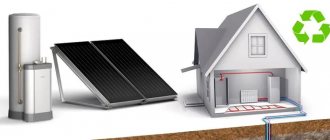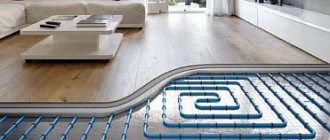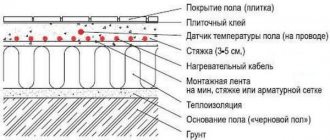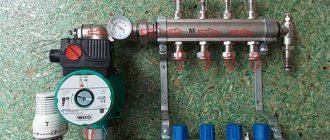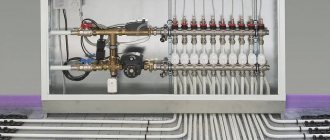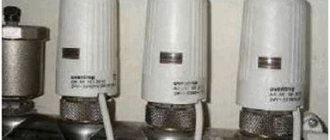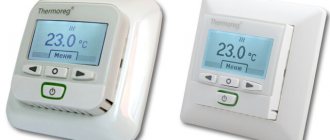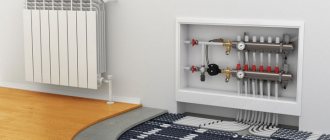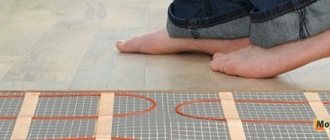Unlike residents of city apartments, owners of private houses can choose their own heating system. It is permissible to install any heating device here - a regular radiator or a heated floor.
However, many private housing developers are perplexed by the question of choosing a heating system. What is better, a warm floor or a radiator, and what will heat the room more efficiently and economically and create a favorable microclimate?
To make the right choice, you need to know the features and operating principle of each system.
We offer you an article with a description of the characteristics and a comparative analysis - what is the difference and what is better, a convector or an oil radiator?
Types of heated floors
Warm floors are divided into water and electric:
- Water - consist of flexible pipes through which coolant heated to 30 - 35 degrees moves. The highway laying pattern can be “snake” or “snail”. Most often they are mounted under a cement-concrete screed. Although, if there are wooden floors, installation is possible without pouring concrete.
- Electric heated floors are:
- cable - this is a wire that can be located under any surface, laid in a screed or between insulation bosses;
- mats - also a cable type of construction, only the wire is already fixed on the substrate (mat) with a certain pitch;
- infrared is a film with built-in carbon plates, no screed is required, the installation process is simple and quick.
Thermal calculation
The main requirement for heating systems of this type is to warm up the premises to 20–24˚C. It is important to take into account that heat is lost unevenly through barriers, say, windows and walls.
On a note
From this point of view, electric floors are undoubtedly inferior to water floors, since they cannot be laid under furniture. In other words, in this case it will not be possible to avoid the formation of areas with high heat losses and cold bridges.
With proper installation, heat transfer along the perimeter of the external walls of the room is optimal and gradually decreases as it approaches its central part.
Types of radiators
If we consider radiators, they are available in three types:
- Aluminum radiators are the most common model. The entire battery body is made of aluminum, which makes it lightweight and increases heat dissipation. The only negative is not high strength.
- Bimetallic heating radiators have an aluminum body with a steel or copper core. The presence of such an insert gives the product strength; it can withstand high pressure and temperature changes.
- Cast iron batteries are a classic; they are still popular today, although they have an impressive weight and are quite inert. They have a long heating time, but they hold and release heat well.
In addition, radiators are divided into gravity and forced. The essence of the gravity system is to heat the water in the boiler, after which, according to the laws of physics, it rises up the riser and falls when it cools.
There are one and two pipes. In forced-action batteries, the presence of a pump is implied, which promotes the movement of liquid in the pipes.
Flooring
For parquet and laminate lovers, we don't have the best news. These materials transfer heat 7 times worse than tiles, which means it will become more difficult to heat the room at an acceptable level.
Porcelain stoneware and tiles are ideal, you can take a closer look at linoleum (if the type of polymer is selected correctly, no unpleasant odors are released during heating, it is an absolutely safe material). They have good heat transfer, so for heating a building only with a heated floor system, they should be considered.
Pros and cons of flooring
Each heating system has its positive and negative sides, and is designed for specific conditions in which it will function more efficiently, so it is worth familiarizing yourself with them.
Which heating system is better: underfloor heating or radiators?
Heating zones (head or feet)
A distinctive feature of heated floors from radiators is the heating method, and this in turn has a significant impact on the microclimate in the room.
For your information! Favorable conditions for a person are warm feet and cool head.
With heated floors, heating of the room begins from below, warm air rises upward and gradually cools. Reaching the ceiling, it practically cools and falls down.
But this gender may have a negative effect for people with varicose veins or allergies. In addition, children will be hot on it for too long, since their blood circulation occurs faster.
Installation
Any repair work creates inconvenience and takes a significant toll on your wallet.
If you install a water-based “warm floor” system in a private house, then in most cases you will need to fill the screed. This is better and more convenient to do at the construction stage of the building. When installing such a floor in a renovated room, you will need to dismantle the flooring.
After which, you can begin installing the warmest structure, which consists of a layer of hydro and thermal insulation, heating elements and concrete screed.
The presence of a concrete layer requires a long time for it to harden, about 28 days, and only then can the finishing coating be laid and the device used.
The cost of the “warm floor” system itself and its installation depends on the components and the heated area. The correct calculation of the number of contours and the laying step are important.
If the pipes are located too often, the surface will overheat and it will be necessary to reduce the heating temperature of the coolant.
But this is not economically profitable, since material costs increase. In addition, the efficiency of the floor is reduced - the contour is too long.
Economical operation
When using heated floors, the heating of the surface is uniform, the air is heated at a distance of 2 meters from the floor covering.
This is exactly the space in which a person exists. In addition, with heated floors, the heat loss rate is 2 times lower than that of a battery, and amounts to 10 - 15%.
Since laying heated floors implies the presence of a “pie” that prevents heat from escaping in vain through the floor (no more than 5% is lost), the device functions more efficiently.
In addition, energy resources are consumed more economically (by 30-50% than with radiators), because the coolant is heated to only 40-45°C.
Difficulty of repair
If the water heated floors in a private house are out of order, then it is difficult to find the cause and carry out repair work, because the pipes are closed with a screed that will have to be dismantled. This work is quite labor-intensive and dusty.
In addition, after troubleshooting, it is necessary to fill the heating elements again with concrete solution and wait until it hardens. However, one cannot help but notice that such breakdowns occur extremely rarely.
Heating rate
Heating of the water structure occurs slowly, since first the liquid inside the pipe heats up, then the screed in which they are located warms up, and only then the floor itself. But they cool down, also slowly.
However, it is worth noting that warm floors will warm up a private home better and faster, because they cover a larger area of the room.
Microclimate
When choosing a heating system, it is important not only its ability to heat the room, but also factors that influence a person’s well-being:
- Air humidity. Heated floors, like any heating system, dry the air. It is recommended to install an air humidifier; this will help improve the microclimate in the room. Although, it is worth noting that water heated floors are a device capable of maintaining water molecules at the required level, so they are preferable for installation.
- Drafts. Warm floors do not create drafts, unlike radiators, since they have low conversion (30%). Another positive aspect of the absence of drafts is that less dust will spread.
- Ventilation. If the room is equipped with a supply fan, then control of incoming air flows is required, and a warm floor will not cope with this task.
Combination with the interior
As with any construction work, flooring plays a big role in creating a harmonious interior. When installing a heated water floor in a private home, it is important not only to fit it correctly into the overall style of the room, but also to choose a model that can be installed on a heated system.
The best option is ceramic tiles; wood is not recommended. Although there are certain models that are compatible with such devices, they are equipped with special markings.
Otherwise, warm water floors do not affect the design of the room, as they are hidden under the finishing coating.
Accessories
Upon completion of the calculation part, they begin to select individual elements of the system. Materials for water heated floors include the following components:
- Pipes. Necessary for transporting coolant and transferring thermal energy into the room. The best choice is products made of cross-linked polyethylene with a protective airtight shell. They are equipped with connecting fittings.
- Control and distribution devices. Manifolds serve to uniformly distribute liquid over individual circuits. The package must include a thermostat and liquid flow limiting devices. For external control, a controller for a heated floor is required - a thermostat.
- Heating boiler. Coolant heating source. Power is calculated according to the parameters of the heated floor. It should not be less than the total nominal value of the entire system.
- Security group. This includes bypasses, pressure valves and measuring instruments - pressure and temperature sensors.
The selection of materials and components should also be carried out by specialists. You should not skimp on the services of professionals - heated floors instead of radiators will be the only source of heat in the house. Therefore, the system must work reliably and quickly respond to changes in outside temperature.
When drawing up a project, it is recommended to provide for the installation of air temperature sensors not only in individual rooms, but also on the street. They are connected to a common control unit. Its settings will allow you to set different thermal modes depending on changes in external factors. These are not required components, but their presence will help optimize the operation of the entire system. The main advantage will be a reduction in energy costs.
Pros and cons of batteries
The battery has long been the main source of heating for premises for various purposes.
In order to determine the advisability of installing them in a private home, you should consider in detail all their pros and cons.
